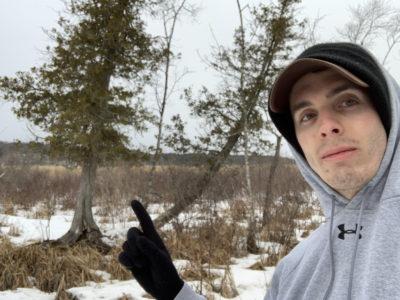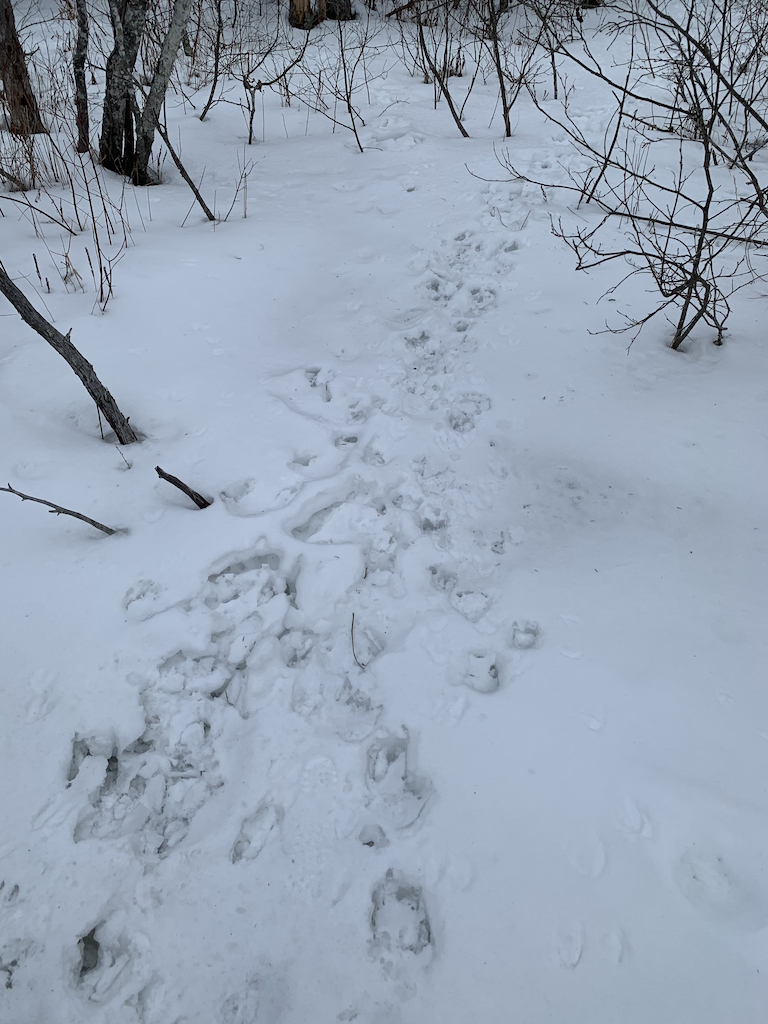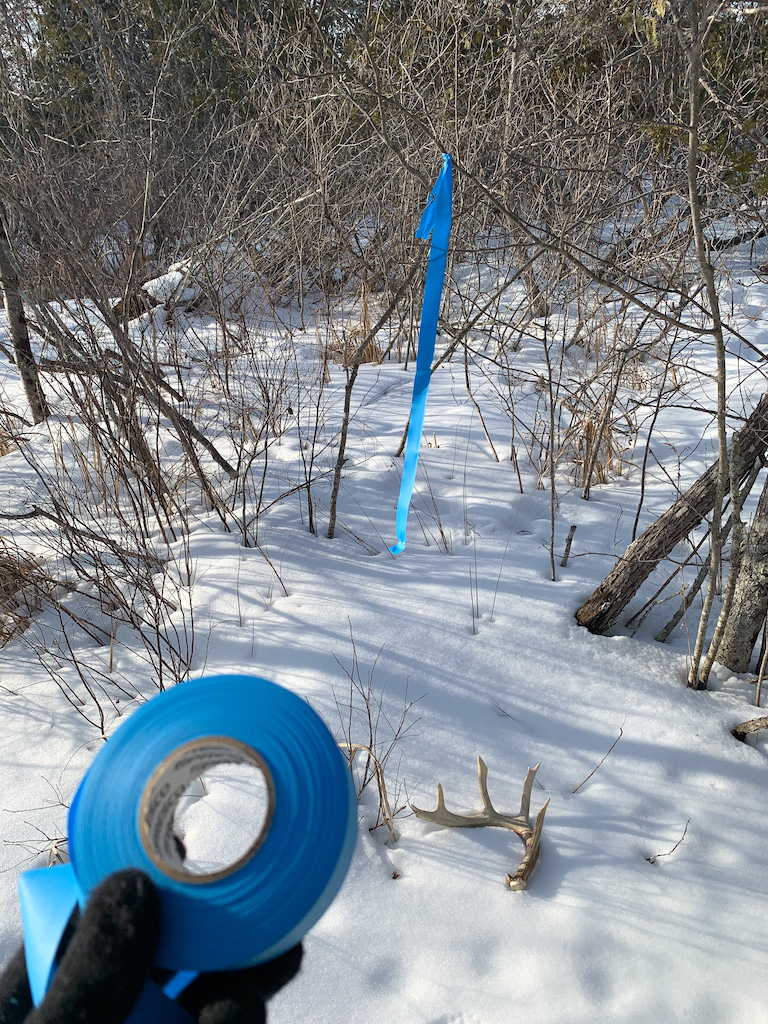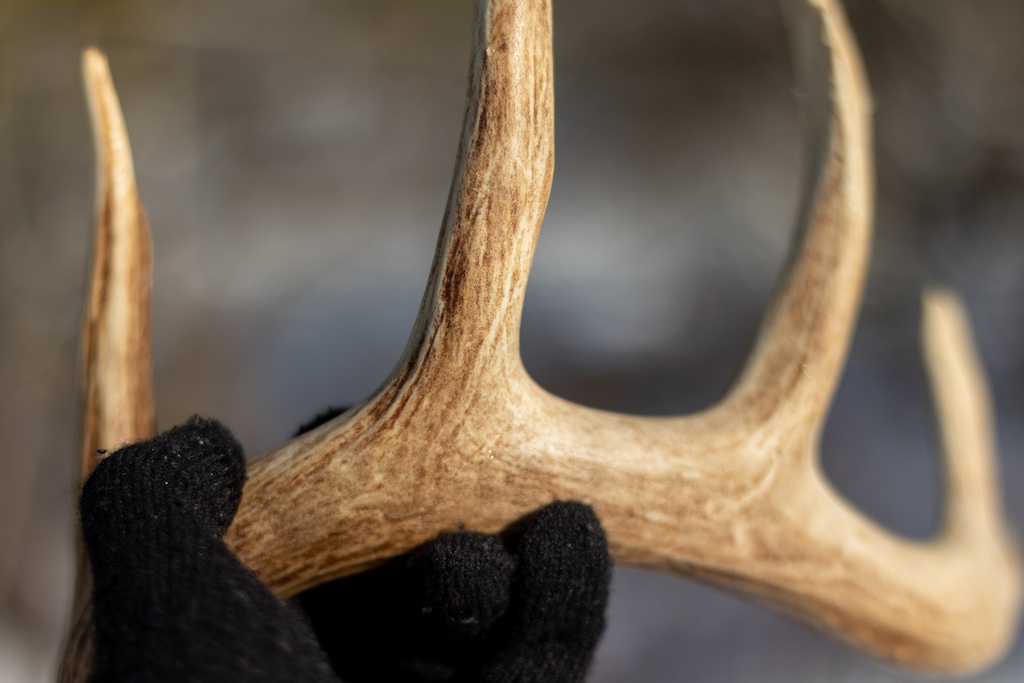Last Updated on May 30, 2024 by Jason Tome
Consistent shed hunting success in Maine has less to do with luck than you might think. These 30 shed hunting tips will enable you to get results by putting the odds in your favor in Maine. It might seem like shed hunting is like searching for needles in a haystack. However, some steps can be taken to increase success and make shed hunting a whole lot more enjoyable.
Table of Contents
1. When Do Deer Shed Their Antlers In Maine?
One of the most important Maine shed hunting tips is to make sure you are searching at the right time. You can spend all the time in the world shed hunting, but if you’re searching at the wrong time your success will be reduced. Many factors influence when bucks will drop their antlers and it varies slightly from year to year. Here’s an interesting article about why bucks cast their antlers early by the Quality Deer Management Association: Causes of Early Antler Casting.
In Maine, bucks start dropping antlers around mid-December with most antlers off by mid-March. It makes the most sense to start shed hunting when the majority of antlers are off, and not before. Waiting until most antlers are off will make sure you have the best chances for success.

2. Don’t Push The Deer Too Early Or Too Often
Pushing deer off a property by looking for sheds too early, or by checking trail cameras too often will likely push bucks off a property. Before you shed hunt an area make sure you wait long enough into the season so that the majority of bucks have lost their antlers. You don’t want to be spooking bucks off a property if they’re still carrying antlers, this will make finding sheds more difficult.
Deer in the winter are in pretty consistent patterns. Following established trails is simply more efficient than creating new paths through the snow. It allows deer to move more quickly and with less effort, which is crucial for conserving energy during the harsh winter months when resources are limited. If you pressure the deer too soon they may change their patterns. By not pressuring the deer you have a better chance of finding sheds on the main trail.
3. Use Trail Cameras
Trail cameras are a great way to determine when bucks in an area are losing their antlers. To do this effectively, leave your cameras out after hunting season is over.
Being careful not to spook deer out of the area, check your trail cameras a couple of times between late January and mid-March. Once you start noticing most bucks have lost their antlers you can determine when to start shed hunting. If you’re after a specific buck’s sheds, trail cameras are a great way to determine when that buck has shed his antlers.

4. Work hard But More Importantly Work Smart
This is one of the best shed hunting tips in my opinion. A lot of time and hard work can be spent shed hunting with little to no success. To have the most success, it is important to shed hunt smart. This means maximizing the amount of time you are in high percentage areas and spending the least amount of time as possible in low percentage areas.
Shed hunting is very much a numbers game. The more time you put yourself in the high percentage areas the better your chances will be of finding sheds. These areas include food sources, late-season bedding, and travel corridors between these two areas. Late-season food sources and bedding areas are explained in greater detail below.
Also, it’s important to know if bucks are wintering in a particular area. Don’t waste your time in areas where bucks are not because the odds of you finding sheds are greatly reduced. Trail cameras are a great way to know if bucks are using an area and thus worthwhile to scout an area.
5. Find The Late-Season Food

Focus on where deer are spending the most time. One area deer spend a disproportionate amount of time in is feeding areas. The late season is energetically expensive for whitetails, especially in Maine because of the harsh winters. This means deer will be feeding very heavily during this time of year. Finding food sources that are being used during the late season will greatly increase your odds of finding sheds.
You might find some great sign right behind people’s houses. This is because deer will eat planted bushes behind people’s houses and sometimes people feed deer behind their houses too which are hotspots and using have heavily traveled trails from their bedding areas.
6. Find The Late-Season Bedding

Late-season bedding areas are another great place to find sheds. In an attempt to reduce energy expenditure at this time bucks are looking to keep as warm as possible. Bedding areas that provide good thermal cover are great places for bucks to bed during the frigid winter months. By focusing your efforts in late-season bedding areas your odds of finding a shed will be much higher than aimlessly walking through the woods hoping to stumble upon a shed with no plan.
7. Travel Corridors

Areas between bedding and feeding areas also provide the potential to hold sheds. Once you have determined the bedding and feeding areas search the area in-between where deer are traveling. There is a good chance a buck could have knocked an antler off in his travels between the two destination areas. Fence lines, streams, or any area where bucks have to jump within travel corridors offer great opportunities for finding sheds. The force of jumping increases the likelihood that an antler may be knocked off.
8. Slow Down In Prime Areas
When you get into high-quality areas (bedding, feeding, travel corridors) make sure you take your time and slow down. It is really easy to miss sheds. These areas provide your best chance of finding them, so go slow and double-check every stick to make sure it is not a piece of an antler.
Speeding up in areas that aren’t high odds and slowing down in prime areas is a good way to maximize efficiency.
9. Virtual Scouting/E-Scouting
Virtual scouting is a crucial step for finding more sheds, and one of the more important shed hunting tips. Using aerial imagery you can often determine bedding areas, feeding areas, and travel corridors. You can do this without even getting off the couch!
Of course, e-scouting will only get you so far but it is a good preliminary step to put the odds in your favor when shed hunting on new properties.
By making a list of areas that look good to you based on the tools you can use on Google Earth you keep yourself in higher quality areas. Virtual scouting will save you a lot of time and energy. Google Earth and Google Maps are my favorite tools for virtual scouting. To learn more about scouting deer using these platforms check out my post: 15 Best Tips for Scouting Deer Using Google Earth.
10. Go To Multiple Properties
After you have thoroughly scouted the high percentage areas of a property don’t waste your time scouting the low percentage areas afterward. Once you have scouted the high-quality areas of a property, leave and scout a new property. This will maximize the time you spend in high percentage areas, which will overall increase shed hunting success.
11. Track Your Path Using A GPS
I like to use a GPS App on my phone to track my path. Being able to see where you have gone will allow you to ensure that you are not looking into areas you have already covered and will show you areas you may have missed. A phone GPS will make you more efficient at searching properties.
12. GPS Mark Locations Of Sheds
Deer, in general, are habitual creatures and tend to use the same areas at the same time each year. For this reason, places where you’ve found sheds in the past are likely to have sheds in the future. By marking the locations of the sheds you will start to develop a database of areas where you have found sheds. This information can be used to improve future shed hunting excursions.

13. Look For A Second Antler
Often when bucks lose one antler the other is not far away. Bucks don’t like the imbalance of having one antler, it makes their head feel awkward. For this reason, they will try to knock the other anter off. Spend time looking in the areas where you found the first shed. There is a good chance you will find a matching set! Using a GPS to mark the first antler and then searching a grid around that first antler could be beneficial.
14. Bring Surveyor Flagging
Surveyor flagging is a very bright-colored ribbon. This ribbon can be used to flag trees over sheds that you have found. The reason to flag sheds is because, as mentioned above, many times bucks lose their second antler not far from their first. For this reason, it can be helpful to place bright-colored flagging over the area where you found the first shed.

When searching for the second shed it is easy to forget the exact location where you found the first. Flagging will make it so you can easily go back and refer exactly where you found the first shed. Being able to refer back to where you found the first shed will allow you to make another game plan for searching the area for the second shed.
15. Stop Scouting, Start Shed Hunting
Out of all the shed-hunting tips, this is probably the one I need to work on most. When shed hunting it is best to forget about scouting. This is still really difficult for me to do. I’ve trained myself to look at tracks and rubs when I’m in the woods during hunting and scouting season.
If your sole reason for shed hunting is to find sheds, scouting will be counterproductive. Shed hunting requires your full attention. By keeping your eyes and mind focused on sheds you will have the most success.
16. Think Small Win Big
A similarity between tracking deer and shed hunting is that when you are tracking you rarely see the entire deer. More often than not it’s an ear twitch or a tail wag that gives the deer away. The same can be said for shed hunting. Instead of looking for an entire shed, look for parts of sheds. Often the entire shed won’t be visible, it could be buried under mud or snow with just the tines sticking up.
17. Shed Hunting With A Dog
Dogs are very effective for finding sheds. Because dogs use scent as their primary tool for finding sheds they can cover ground faster and more effectively. They also can find sheds in the ‘thick stuff’ which is useful for finding those sheds back in the dense bedding areas. If you’re curious about how to use dogs for shed hunting check out; The Basics of Shed Dog Training and The Best Shed Hunting Dog Breeds.
Even if your dog isn’t trained to find sheds, taking your dog along with you is a great way to have more fun when shed hunting.
18. South Side Of Ridges
The south sides of the ridges get the most sunlight. For this reason, bucks like to bask in the rays during the cold months to warm up. Bucks also like to bed under small evergreen trees for thermal protection on these south-facing ridges for additional warmth and protection. Make sure to check under these evergreen trees on the south sides of the ridges, you might be in for a welcome surprise. Additionally, south-facing ridges are the first to melt. Less snow means sheds will be less buried offering better opportunity.
19. Bring Binoculars
Binoculars are a useful tool for scanning fields and for confirming a visual on a potential shed in the distance. This saves you from walking up to every bleached stick or white rock. Binoculars are also nice just to have to observe deer if you bump any, and for observing wildlife in general.
20. Bring Safety Glasses & Sunglasses
The glare from snow during sunny late winter or spring days can make finding sheds difficult and can give you a headache. Safety sunglasses reduce glare, making shed hunting easier and more enjoyable. I prefer polarized sunglasses to help cut down on the glare.
Additionally, bucks often drop their sheds in thick bedding areas such as swamps. Safety glasses/sunglasses will allow you to plow through thick brush without taking a stick to the eye. You can get them pretty cheap on Amazon. You can get a pair of polarized glasses for around 15-25$.
21. Make A Day Out Of Shed Hunting
Bringing everything you need to make a day out of shed hunting is a great way to improve your odds of finding sheds. Bringing food, water, or anything else you might enjoy will ensure you are as comfortable as possible. Hunger is very distracting and often causes you to head home early. Having snacks out in the woods will satisfy your hunger and allow you to spend more time in the woods. The more time you can spend in the woods, the better your chances are of finding sheds.
22. Mental Focus
Having the right state of mind plays a big role in shed hunting success. The minute you stop concentrating on what you’re looking for is the moment a shed slips by unnoticed!
23. Discouragement Prevention
It’s easy to get discouraged after long days without finding any sheds. Shed hunting isn’t easy. It takes a lot of walking in the right places to find them. Some great ways to keep from getting discouraged is to bring friends or bring a dog. Having company makes shed hunting more enjoyable. Also, you can add a competition component to it, which turns shed hunting into a game that boosts spirits and helps to prevent discouragement.
24. Make Sure Bucks Are In The Area
Some areas are hunted more than others during the actual hunting season. Bucks in heavily hunted areas just aren’t as numerous as they are in lower hunted areas. Also, a lower percentage of bucks can make it to an older age class. A lower age class means sheds will be smaller than unpressured areas where bucks can grow to maturity.
Lower buck densities combined with smaller sheds make finding sheds in heavily hunted areas more difficult. Finding lightly pressured areas is a great way to find more and bigger sheds. Areas that do not allow hunting or have limited hunting seasons could be a good bet for finding more sheds.

25. Set Realistic Expectations Depending On Where You Live
Everyone wants to find those giant sheds. But you have to be realistic depending on where you live. Not every area will be able to produce Iowa-sized racks. Make sure you set your expectations based on what your area holds for bucks to avoid disappointment. By setting realistic expectations you will be able to accurately visualize what size sheds to search for when shed hunting.
26. Dress Accordingly
Having the proper attire when shed hunting helps to keep you in the woods longer. Shed hunting requires a lot of walking, and walking at variable paces. For this reason, you want to wear clothing that will keep you warm when you’re walking slowly in high opportune areas.
That being said, you don’t want to dress so warm that when you have to pick up the pace you overheat and sweat. Getting overheated and sweating will drain your energy and make you want to head back to the truck. Additionally, if you start sweating you’ll become cold when you have to slow down in the high opportune areas.
I am a big advocate for wool clothes for shed hunting. Wool clothes keep you warm when wet, they are water-resistant, fast-drying, warm, and quiet. You may want to bring extra gloves if it’s rainy or there is snow melting off trees. Having an extra pair of gloves is nice after wearing wet gloves for a while.
27. Bring A Backpack
Bringing a backpack is very helpful. You’ll want a backpack to put your lunch in and any other useful things you might want to bring. Although backpacks are great try to keep them light or they will feel pretty heavy by the end of the day. Some things to throw in your backpack could be a compass, GPS, extra gloves, survey flagging, sunglasses, lunch, and of course for putting sheds in!
28. Shed Hunt On Rainy Days
Don’t let poor weather hold you back! When antlers get a sheen of water on them they tend to shine and glisten. For this reason, light rainy days or the day after a rainy day is a great time to be out looking for sheds. Additionally, overcast rainy days block a lot of sun which reduces glare making for good shed hunting. Additionally, after rain, the snow around sheds has melted, making them even more obvious.
29. Practice

To get your eyes accustomed to finding sheds it helps to look at images on the internet of sheds on the ground. It is also a good idea to bring some older sheds with you and place them in random locations at the beginning of the shed hunt. Then walk about and observe the sheds to train yourself on what to look for. Although this sounds a little odd, it does help.
30. Shed Hunt In Deer Wintering Areas
In the northern regions deer congregate together in deer yards. These deer yards are found in areas that provide good shelter from the snow. These areas consist of dense softwood stands that block a lot of snowfall. Because of the sheltering effect from the softwoods stands the snow depth is much less.
These areas are great places to check for sheds because deer are congregated in these deer wintering areas. It is not recommended to continually disturb deer that are in these deer wintering areas in the middle of winter. Bumping deer in these areas at this time causes them to expend needed energy and creates stress. Energy is valuable to deer at this time because they need all they can get to fight the elements and evade predators. When conditions improve in early Spring is a great time to start looking for sheds in deer wintering areas.
Conclusion
Properly preparing for shed hunting and continuously putting yourself in high-odd areas will greatly increase your chances of finding sheds in Maine.
These 30 Maine shed hunting tips combined with hard work will have you collecting more sheds than ever before. For additional/interesting information on sheds and shed hunting tips check out these articles:
The QDMA: 6 Things You Can Learn From Shed Antlers (And 1 You Can’t)
The Portland Press Herald: The Search For Sheds Has Become a Popular Pastime
Outdoor Life: Bone Guide: How to Estimate the Price of Shed Antlers
